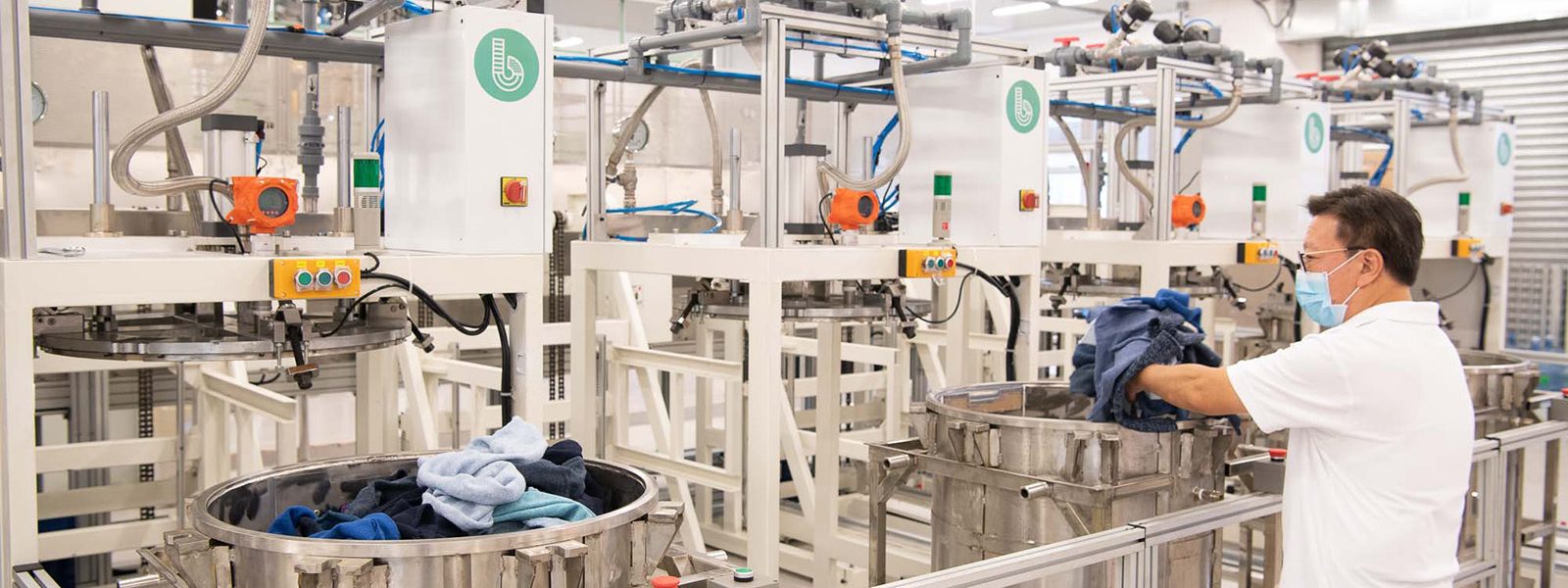
The State of Fashion 2022 Novetex: Encouraging Brands to Raise Their Game on Circularity
EXECUTIVE INTERVIEW
by Rachel Deeley

As fashion brands look to pursue closed-loop recycling solutions, it is increasingly important to engage with suppliers who can help them move toward sourcing circular materials. Novetex Textiles has developed its own mechanical recycling process — a waterless, mostly automated system that produces no chemical waste — but the company’s chairman Ronna Chao says reaching industrial scale and mass adoption of the new technology is a ‘chicken-and-egg’ conundrum.
Material innovations have long been front of mind for Novetex Textiles chairman Ronna Chao, but full circularity is a more recent endeavour at her family business, which spins yarns like Merino wool, cashmere and cotton to be shipped off to textile mills and knitters. In 2019, Chao negotiated a partnership with the Hong Kong Research Institute of Textiles and Apparel (HKRITA) and the H&M Foundation to develop a patented mechanical recycling-process: one that is waterless, chemical waste-free and almost entirely automated.
The six-step Billie System, named after Chao’s late grandfather and Novetex’s founder, sees unwanted fabric sanitised, separated from hardware like zippers and buttons, chopped to size, sorted by colour, shredded and sanitised again, then shipped as spools of fibre from Novetex’s Hong Kong headquarters to be spun into new yarn at its other factories in nearby Zhuhai, mainland China. As fashion brands’ interest in circular principles continues to grow, Chao discusses some of the remaining sticking points — from the limitations of recycled fibres to logistical and regulatory roadblocks — and outlines where the industry’s biggest players need to step up.
You’ve previously said that all your clients — both textile mills and consumer-facing brands — are now prioritising sustainability, and that Novetex’s work is just one part of the bigger picture. What else needs to change across the value chain to create a truly circular economy for apparel?
I really think brands can do a great deal by sharing their stories, and the biggest barrier that I think we at The Billie [System] see nowadays is that when a lot of these brands come to us, they want to work with us, and they’re very enthusiastic, but they do not want us to mention their names, they do not want to tell a story, and so the good work that they’re doing in terms of sustainability and circularity is not widely known.
How could brands tell a better story about the closed-loop recycling that’s now available from players like Novetex?
It’s not just [about] having a label on the garment that says, “I used to be an old sock,” it’s more advocacy, maybe working with universities, working with research institutes… I think it’s also good to tell the story of partnership, so if it’s with a certain sorting company, or working with a certain logistics company, the story of different types of partnerships along the way, that could be very meaningful. The more people get involved [and] join this consortium, the better… Maybe storytelling is not the right term, and advocacy sounds too political — but really pushing it out. If somebody is doing something good, why don’t they want to tell the world about it? That’s what I want to say, because when they tell the world about it, that could really result in multiple layers of influence and a change in mindset and behaviour.
As a yarn producer, Novetex is quite far-removed from the final stage of garment manufacturing. How important is it that brands engage directly with you, rather than relying on the dialogue between yourselves and the next tier of suppliers?
It’s very, very important, and I think over the last two decades our role has changed from just dealing with the knitter to very often dealing with the designer and the brands directly… which is wonderful… We also have our role to play in pushing… the movement forward. There are two [practical] ways to work with The Billie [System]. One is only to provide textiles for processing without buying any upcycled products from The Billie; the second is to purchase all the knitted products from the provided materials for a closedloop cycle.
What are some of the remaining challenges when it comes to integrating recycled materials into existing apparel supply chains?
That is a question that I would love to hear the answer to from the brands. For us, we’re on the other side, trying to convince people, that “maybe [sourcing recycled materials] is a little bit pricier than what you’d expect, but this is something you must do.” You may not be 100 percent circular or 100 percent sustainable from day one, but that has to be something that we move towards.
Are there issues with scaling and reaching that critical point of maturity in the technology?
Well, [brands] don’t discuss scale with us, because they’re not asking us for 20,000 pounds of upcycled textiles. In the few conversations that I’ve had with brands where we’ve gone a little bit beyond [that and] touched… on the topic of, “let’s close the loop,” what I’ve heard would be [questions about] quality and cost. Sometimes they do ask about scale, but it seems like they expect quality to be very, very high [and for] the cost to be much lower. They’re giving us a mishmash of things, and they want something that comes out from all of that to be very useable and uniform. Perhaps there’s a disconnect between what they’re giving us, or what they think can be done with their textile waste, and what they’re looking for.
Cost is certainly a factor; recycled fibres are typically more expensive than their virgin counterparts. When do you expect to see economies of scale, so that the cost of recycled fibres will be just as affordable, if not cheaper?
It’s a real chicken-and-egg situation, because in order to reach that scale, we would need many, many more people to adopt using recycled fibres and yarns 80 The State of Fashion 2022 in their design and production. Everything is connected; if consumers demand more of it, then the brands will make more, and then they’ll place more such orders with us.
“In order to reach that scale, we would need many, many more people to adopt using recycled fibres and yarns in their design and production.”
The Billie System currently secures most of its feedstock from B2B partnerships with fashion companies and hotel groups, which can provide unsold inventory, bedsheets or old uniforms, but is there an opportunity to bring postconsumer fashion waste into textile-to-textile recycling?
Right now, if there can be largerscale collection and sorting, that would help us tremendously. I have limited space where The Billie is housed, so I can’t be the collector and the storer and the sorter all at once. We always talk about partnerships; if we can partner with, for instance, NGOs or other players within the industry [in other countries] where they can do the collection and the sorting, then let’s say after six months they collect two tonnes of red sweaters, one tonne of beige sweaters, then we can process that in a more meaningful way.
It’s interesting that you mention other key geographies. In Kenya and Ghana, for example, there are entire industries and livelihoods built around buying and selling bundles of used clothing. How do these ecosystems form a part of a closed-loop, circular economy?
I think it’s two separate things. I often say, The Billie System is not a garbage processing machine. We didn’t create The Billie so that people can continue to make more, and sell more, and throw away more. It’s really a tiny, tiny, tiny part of the solution. The greater effort needs to come from how we look at design, how we look at sourcing of materials, how we look at merchandising, production, marketing and sales, consumption and then disposal.
Where do you see the potential for the fashion industry to really adopt circular design in earnest?
I think the larger the brand — and this is a very personal observation based on my experiences talking to these people — the bigger the disconnect between the departments. For instance, I can have a very, very meaningful and enthusiastic conversation with the sustainability division of a brand. They’re very helpful, they connect me with the different people in different locations to try to address the issue, but they may not be the ones to have any influence [over] design or merchandising. The design team may also have strong opinions or initiatives about sustainability, but they may not be as connected to the material sourcing part of the company. The smaller brands that we’ve worked with are more nimble, because the decision process and the range of influence is smaller. They can make decisions quickly, and the course of direction can change very quickly, or they can just decide, “Okay, we’re going to make 300 pieces of this using our textile waste.” In most cases, they’re willing to tell that story.
One challenge with mechanical recycling is that it produces shorter fibres that need to be blended with virgin fibres to bolster the quality. Is there a point where the technology will evolve enough so that it becomes truly selfsustaining?
We’re constantly in discussion with HKRITA about how to upgrade the parts in The Billie System… Right now it’s only under ideal situations that I can process the [maximum capacity of ] three tonnes per day… I don’t know when we can achieve that, where someday we will not have to use virgin fibres. Unless consumers don’t mind [shorter, rougher fibres, but] I think [they] are very spoilt nowadays; everything has to feel good, be light, with all these performance qualities; it has to be cheap, and it has to be beautiful. I won’t say it will never happen, but currently I don’t see it happening within a short time.
Your system can recycle textiles made from 100- percent natural fibres, but what about those blended with synthetics?
In order to produce high-quality recycled fibres, The Billie [System] prefers textiles from 100 percent natural fibres.
Can The Billie System process textiles containing natural fibre blends, like a cotton-wool blended sweater or linencotton blended T-shirt?
Yes.
How are fibres separated out, if at all?
As a mechanical recycling system, we cannot separate the fibres through the upcycling process, so we prefer to collect items that have no more than two fibre combinations to maintain the purity of the recycled fibres.
Regulators are increasingly turning their attention to environmental policies that will implicate the fashion industry, both directly and indirectly. How do you think the apparel industry can really seize this as an opportunity to become circular?
Well, I’ll take ourselves as an example. [We have] difficulty shipping our fibres directly from our Hong Kong factory to our Zhuhai factory because there’s a rule against importation of waste. Now, I know that this rule probably came from many, many years ago when China was, like many developing countries, accepting other countries’ garbage… [but] the rigidity of that rule affects us because what goes through The Billie is sanitised three times, but it’s still labelled as waste. [As one company] it’s very difficult for us to go and lobby [regulators] to change that rule, so ideally, if… there are 20 people like us going to lobby them then it probably makes more sense for them to really take a stand, but if it’s just me and The Billie it’s harder for them to make a case. Those are the kind of things that we face, and it is frustrating.

